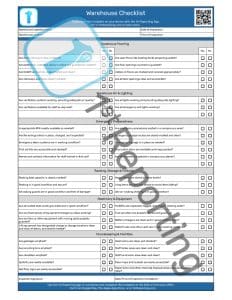Having a warehouse to run can be a lot of work. Using a warehouse checklist template to help with your warehouse reporting and auditing is a great way to make that work more manageable.
From a warehouse safety inspection to a daily warehouse audit, using the warehouse checklist template helps speed up and maintain your operational effectiveness.
Reducing hazards around your workplace is essential to preventing accidents and injuries. Less important but still of value is the reduced risk exposure for your business.
Regularly scheduled warehouse audits, such as shift startup audits or daily warehouse inspections, are critical tools in your safety toolbox. We’ll discuss what this tool includes, some tips for using the template, and some further tips and tricks to help you get your warehouse reporting processes on track while increasing efficiency. Let’s dive into this free and actionable template.
Included In The Warehouse Checklist Template
The Warehouse Checklist Template is divided into seven convenient sections. Each section serves a particular aspect common to warehouses and has two open cells to add your own customizations. Here is the breakdown of the sections:
- Administrative
- Flooring
- Air & Lighting (Work Environment)
- Emergency Preparedness
- Racking, Storage & Fixtures
- Machinery & Equipment
- Housekeeping & Facilities
Administrative
No report or audit would be complete without an administrative section. This section includes the top and bottom of the template, where the auditor or inspector notes their name, date, location, and signature at the bottom of the document to verify completion.
Flooring
One of the most common places where injuries happen is the floor. That may seem silly, but slips, trips, and falls are some of the highest types of warehousing-related injuries. Warehousing already has a bad record of 4.8 injuries or illnesses reported per 100 workers. Keeping the floors clean and free of debris and trip hazards is a massive step to preventing your company from being a part of these statistics. (source)
Air & Lighting (Work Environment)
The standard box-holding warehouses tend to have a lot of cardboard dust. Not only that but sometimes lights burn out. Doing your shift walk-through or daily startup procedure, you may notice a bulb burnt out or a light malfunctioning. It is crucial for safety that both the lights work and that the air is clean and safe for your staff to breathe.
Factories that utilize propane-powered forklifts must adhere to specific standards for air ventilation. Ensuring your warehouse climate is comfortable and safe for your staff is vital. The air and lighting section allows you to assess and note your warehouse lighting and air quality.
Emergency Preparedness
The second most common infraction that businesses face regarding OSHA inspections is hazard communication. This communication involves posting specific posters, procedures, or other information, such as GHS documents, where they are easily accessible in the workplace.
Other essential emergency preparedness topics are addressed within this section as well, including but not limited to emergency alarms, fire extinguishers, and other emergency equipment commonly found in warehousing.
Racking, Storage & Fixtures
One of the most dangerous things in a warehouse is the racking. When improperly maintained, racking can cause severe injury or even death if it cannot sustain the weight of product storage. There are rules to follow for racking, and regular inspections are critical to preventing racking failure.
This section covers more than just racking. Several other questions relate to storing products and fixtures, such as non-rack shelving units and other everyday things found in warehousing.
Machinery & Equipment
It was mentioned how racking is a potentially deadly danger in the warehouse. However, we should note that the racking on its own, if properly installed and maintained, only becomes a danger when you incorporate the use of heavy equipment. In this case, we’re referring to forklifts. The number one cause of warehouse racking failures is altercations with forklifts. (source)
Many forklift operators see heavy racking and assume it is strong and can withstand minor impacts. Although it is strong, the withstanding impacts are not realistic.
Most warehouses that use racking systems also use protective bollards and guarding systems to prevent accidental collisions with forklifts. These guards find a place in the machinery and equipment section of the warehouse checklist template, as do equipment storage areas and more. Again, similar to every other checklist section of the template, two empty cells are provided to customize the template to your individual company’s needs.
Housekeeping & Facilities
As mentioned earlier, some of the top injuries reported by workers in the warehousing industry are slips, trips, and falls. Housekeeping has a significant role to play in preventing these types of accidents. General housekeeping and general facility audit questions appear in our final checklist section of the warehouse checklist template. Again, the section includes two empty cells for customization.
If further customization is what you’re looking for in a warehouse checklist template, then you should try the 1ST Incident Reporting mobile app. It works on nearly any device and is a cloud-based solution for warehouse and job site reporting, auditing, and more. With all kinds of customization potential, you can have the warehouse checklist explicitly tailored to your operation. But I’ll explain more about the mobile reporting app later in the article, so keep reading to find out how you can increase your reporting efficiency exponentially to save time and money.
How To Use The Warehouse Checklist Template
Using the warehouse checklist template is as simple as downloading and printing a PDF file. Just download it, print it, and provide copies to your staff performing your warehouse audit.
We recommend using the document as a daily checklist template for your warehouse. Whether or not you run multiple shifts, doing a shift or daily walkthrough is a great way to prevent injuries and accidents and lower maintenance costs by catching issues early via inspection. That’s not all the reasons why a daily warehouse audit is suitable for your business. Let’s dive a little deeper into the other things this process and template are great for, for your business.
Why A Daily Warehouse Audit Is Good For Your Business
Performing a daily or shift warehouse audit using our warehouse checklist template is an intelligent process implementation. As mentioned above, a daily warehouse audit aids in preventing accidents, injuries, and costly breakdowns. And there’s more that the daily warehouse inspection does for your business.
Here is a breakdown of all the benefits of using a warehouse checklist template and performing daily warehouse audits:
- Lowers chances of employee injuries
- Lowers chances of near-miss incidents
- Lowers chances of dangerous situations
- Reduces company risk exposure
- Facilitates management of personal risk exposure
- Reduces costly downtime from equipment or facility breakdown
- Increases company culture of safety
- Increases work environment safety
- Increases proof of company due diligence
There are more than enough reasons to use the warehouse checklist template. From the generic pre-filled questions to the supplied blank cells for customization, the warehouse checklist template is everything you need to do your daily warehouse audit and inspection.
If printing and using paper the old-fashioned way isn’t your cup of tea, then read on to find out how your business can take advantage of a fully digital reporting system.
Using Digital Mobile Solutions For Your Warehouse For Better Efficiency
We know running your warehouse can be a lot of work. Worse yet is the toll it can take on your time. As a manager, you understand that time is valuable. Time is money. And so are printer ink, filing cabinets, paper, printers, and staff to use these tools and organize the paperwork that ensues. What if we could streamline a considerable part of that paperwork process?
At 1st Reporting, we have done just that. We’ve created a massively useful platform for your customized reporting needs. Whether it’s a vehicle or equipment inspection checklist, an incident report, or even a facility audit checklist, our template library of reports, audits, checklists, and other useful forms provides you with a solid foundation to build your mobile reporting process.
The sort of customized notifications you would want when a staff member completes something like a dangerous situation report comes standard with the 1st Reporting mobile app. So, whether your staff uses smartphones, tablets, laptops, or other devices to complete their report, inspection, or audit, you can get notified the moment they hit that save button.
Gone are the days of dialing rotary phones and filling out piles of paperwork. Take advantage of a digital reporting system and find out how the automated processes, instant notifications, customization, and instant file retrieval of a cloud-based platform, accessible on almost every device, can help increase your company’s reporting efficiency today.






